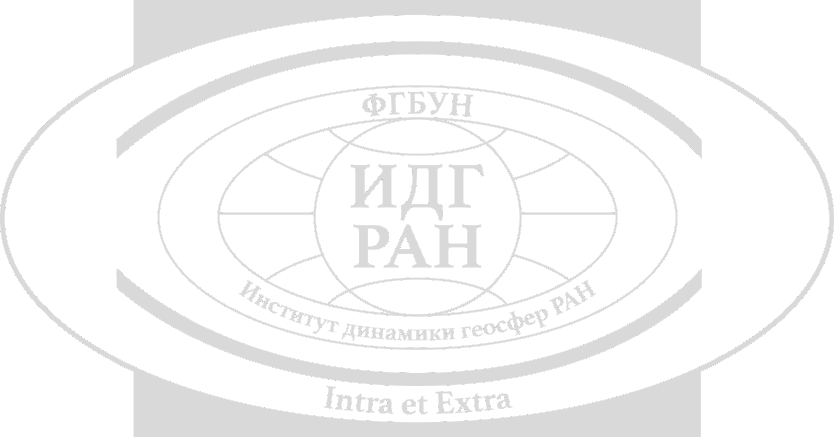The Mechanics of Slow Slip on Faults and Fractures
CONDITIONS OF ORIGINATION AND POSSIBILITY OF TRANSFORMATIONS.
CONSEQUENCES AND IMPORTANCE FOR SEISMIC HAZARD REDUCTION.
The results of the project are presented in series of Publications and at International Conferences.
- Publications
- Kocharyan G.G., Kishkina S.B., Novikov V.A., Ostapchuk A.A. 2014. Slow slip events: parameters, conditions of occurrence, and future research prospects. Geodynamics & Tectonophysics 5(4). doi:10.5800/GT-2014-5-4-0160.
- Besedina A.N., Kishkina S.B., Kocharyan G.G. Effect of deformation properties of discontinuities on sources of mining-induced seismicity in rocks. Part I: In situ observations // Journal of Mining Science, 2015, vol. 51, Issue 4, p.707-717.
- Ostapchuk A.A., Pavlov D.V., Markov B.K., Krasheninnikov A.V. Study of Acoustic Emission Signals During Fracture Shear Deformation // Acoustical Physics, 2016, vol. 62. №4, p. 505-513.
- Kocharyan G.G., Novikov V.A. Experimental study of different modes of block sliding along interface. Part 1. Laboratory experiments // Physical Mesomechanics, 2016, vol.19, №2, p.189-199.
- Adushkin V.V., Kocharyan G.G., Ostapchuk A.A. Parameters Determining the Portion of Energy Radiated During Dynamic Unloading of a Section of Rock Massif // Doklady Earth Sciences, 2016, vol.467, №1, p.86-90.
- Besedina A., Vinogradov E., Gorbunova E., Svintsov I. Chilean Earthquakes: Aquifer Responses at the Russian Platform // PAGEOPH, 2016. vol.173, №4, p.1039-1050.
Abstract: We studied hydrogeological responses to the passage of seismic waves from the Chilean earthquakes with Ms ≥7.6 at epicentral distances of about 126°. The variation in the levels of confined and unconfined aquifers was analyzed under platform conditions at the Mikhnevo Geophysical Observatory near Moscow, Russia. Synchronous recording of seismic and hydrogeological data enabled us to evaluate the amplitude–frequency response of aquifers. The study shows that medium response to dynamic impact depends on various physical parameters of the aquifers.
- Kocharyan G.G., Novikov V.A., Ostapchuk A.A., Pavlov D.V. A study of different fault slip modes governed by the gougew material composition in laboratory experiments // Geophysical Journal International, 2017, vol.208, №1, p.521-528, doi: 10.1093/gji/ggw409.
Abstract: Described are results of laboratory experiments which revealed regularities of gradual transition from stick-slip mode to aseismic creep. The behavior of model gouge-filled fault was investigated with experimental setup of the spring-bock model. It was experimentally proven that small variations of a percentage of materials with velocity strengthening and velocity weakening properties in the fault principal slip zone may result in significant variation of the portion of seismic energy radiated during a fault slip event. The tests simulated different modes of inter-block sliding whose characteristic values of scaled kinetic energy varied by several orders of magnitude, while differences in contact strength and shear stress drop remained relatively small. The obtained results led to the conclusion that the earthquake radiation efficiency and the fault slip mode are governed by the ratio of two parameters – maximum fault slip-weakening rate and shear stiffness of the enclosing massif. The ratio can be essentially changed by small variations of the material composition of the fault principal slip zone.
- International Conferences
- Gorbunova E.M. (2014) Monitoring of underground water regime at the sites of large-scale experiments // VII International Conference «Monitoring of Nuclear Tests and their Consequences», Kurchatov, Kazakhstan
- Ostapchuk A.A., Kocharyan G.G., Pavlov D.V. (2015). Some conditions of different deformation mode formation // 20th Deformation Mechanisms, Rheology and Tectonics International Conference, Aachen, Germany.
- Budkov A.M., Kocharyan G.G. (2015). Composite fault slip simulation using a spring-block model with a rate-and-state friction law // 26th General Assembly of the International Union of Geodesy and Geophysics, Prague, Czech Republic.
- Kocharyan G., Novikov V., Ostapchuk A. (2016) Transformation of a stick-slip mode of fault behavior into a stable sliding in the laboratory tests at the spring-block model // AGU Chapman Conference on the Slow Slip Phenomena. Ixtapa, Mexico.
- Ostapchuk A. (2016) Laboratory investigation of conditions of slow slip event generation // AGU Chapman Conference on the Slow Slip Phenomena. Ixtapa, Mexico.
- Kocharyan G., Ostapchuk, A. and Pavlov D. (2016) Laboratory study of fault slip modes and earthquake radiation efficiency // 35th General Assembly of the European Seismological Commission, Trieste, Italy.


